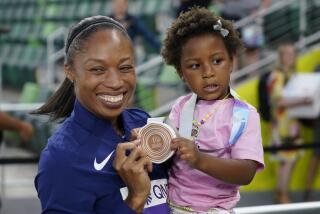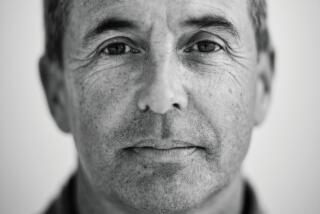Cartoon Feline Is Catalyst for Car Dealer’s Success
- Share via
Felix the Cat reigned over the silver screen years before he found his way to a Figueroa Street car dealership. Created in 1919 by artist Otto Messmer, the animated cartoon character even predated Mickey Mouse.
But these days the feline is better known for his connection to cars, at least in Los Angeles. An ambitious entrepreneur named Winslow B. Felix embraced the cartoon character as his own in 1923, shortly after he founded his Chevrolet dealership at 11th and Olive streets. It has been at its current location near the Harbor Freeway since 1958.
The original dealership was smack in the middle of downtown’s “Auto Row,” an auto mall roughly bounded by Figueroa and 7th streets, Washington Boulevard and Broadway. Dozens of dealerships have come and gone, including outposts for such short-lived models as the Mercer, Jordan and Pope-Toledo. Most of the dealerships began moving to the suburbs after World War II.
Winslow Felix, born in Tucson in 1894, came to Los Angeles after fighting in World War I. He sold used cars, then opened a Chevy dealership in 1922.
This was the Jazz Age, when L.A. was booming from oil, movies and subdivisions. Statistically, at least, there was a car in every household. Winslow Felix wanted to ensure that most of them were Chevys.
His clever marketing gimmicks earned him a statewide reputation. He came up with a “trial purchase plan,” which other dealers scrambled to match. If a customer was unhappy after two days with a new car, Felix would refund the purchase price and even offer reimbursement for the money spent on gas.
Felix’s service manager and brother-in-law, Paul Parsons, made house calls. “We don’t wait for the owner to bring it to us,” Winslow Felix told a reporter in 1925. “When adjustments are necessary, [Parsons] makes them on the spot.”
“My grandfather’s dealership also had a three-wheel motorcycle with a hook, battery booster and set of tools,” said Bill Gonzalez, 74. It was an early version of a tow truck; all the rider had to do was “hook up the car and tow it back for service.”
Gonzalez, former owner of a Buick dealership, lives in Leawood, Kan., a suburb of Kansas City. “My grandfather was everything I ever wanted to be,” he said.
At 27, Winslow Felix helped found the Greater Los Angeles Motorcar Dealers Assn., which rated the performance of new cars and customer satisfaction. He also helped organize the annual Southern California auto shows and sponsored auto races and baseball teams.
But his quirkiest coup may have been Felix the Cat. In 1923, the cartoon character was already famous. His image adorned clocks, Christmas ornaments and, once, a balloon in Macy’s Thanksgiving Day Parade. Although Messmer had created him, he didn’t have the rights; those belonged to Messmer’s boss, Pat Sullivan, a Hollywood illustrator who was credited as the crafty cat’s creator.
Sullivan was also a friend of Winslow Felix; he gave his friend permission to use the cartoon as a marketing tool.
“All Sullivan wanted was a free car out of the deal,” Gonzalez said.
Winslow Felix began advertising Felix the Cat at the 11th Annual Auto Show in 1923, picturing the animated feline carrying a briefcase with the Chevrolet logo and the words “Order Yours from Felix.” He also attracted attention of potential buyers by painting the “good luck” feline all over his Chevrolet roadster convertible and driving a giant head of the cat around town in the back seat.
Winslow Felix also used the cartoon cat to advertise on the side of mobile libraries, which played music much like Good Humor ice cream trucks. The gimmick reminded children to check out a book and their parents to buy a Felix Chevy.
Winslow Felix had a colorful personal life, too. His longtime girlfriend was a silent-screen movie star, Lois Wilson, whose credits included the 1923 western epic “The Covered Wagon” and “The Great Gatsby” in 1926. Gradually he began to hobnob with other Hollywood celebrities.
He and his wife, Ruth, separated.
“But they never divorced,” Gonzalez said, “My mother, Alice Felix Moench, was their only child, and she told me that Wilson always treated her like a daughter.” Wilson also became godmother to Felix’s grandchildren.
By 1931, most of the Figueroa frontage had been purchased by other car dealers. Felix moved his headquarters to 12th Street and Grand Avenue, opening a modern three-story office and showroom. Tuning up his sales pitch, he won contracts to supply fleet cars and trucks to various Southland cities.
“Company cars with the dealership name were emblazoned in big chrome letters,” Gonzalez said. “With spectacular lighting, he made the showroom autos look like jewels sitting in the middle of a jewelry box.”
In 1934, Gilmore Stadium showcased midget car races Thursday nights, and Felix was there to sponsor the sport. The stadium was where CBS Television City now stands on Beverly Boulevard.
Winslow Felix belonged to a carousing outfit called the Uplifters Club in Rustic Canyon, which was a favorite stop on the international polo circuit.
At the club, money and clout were taken for granted, and polo was at the heart of it all. The club’s polo roster eventually included such celebrities as Will Rogers, Walt Disney, Spencer Tracy and Daryl F. Zanuck.
On May 31, 1936, Felix was playing in a polo match on the Freebooters team against the Riviera Blues at the Riviera Country Club. Minutes into the hotly contested match, Felix’s horse collided with Reginald “Snowy” Baker’s mount, throwing both riders to the ground.
Baker ignored injuries to his head and shoulder to get himself and Felix off the field before they were trampled. Baker went back to the game while Felix was rushed to the hospital, where he died the next day of a head injury. He was 42.
His widow, Ruth, took over the business -- which defied General Motors’ policy against women running dealerships. But although she was the owner, she was merely a figurehead.
“Claude Craig was the company controller, who my grandfather called ‘Old Eagle Eye’ because he was so clever with numbers,” Gonzalez said. “He was the one who really ran the company.”
When Craig died in 1955, Ruth Felix sold the business for $675,000 to used-car salesman Nickolas N. Shammas.
The Felix dealership became the linchpin of an empire that eventually included seven automobile dealerships under Felix Cadillac-Chevrolet and the Downtown L.A. Motors banner. Shammas bought the landmark Petroleum Building at Flower Street and Olympic Boulevard in 1969 and turned it into his headquarters. In 1958, Shammas moved the Felix dealership to its present site on Figueroa near the newly opened Harbor Freeway. On top, he erected a giant neon sign of the black cat with huge white eyes, grinning over the Figueroa corridor.






